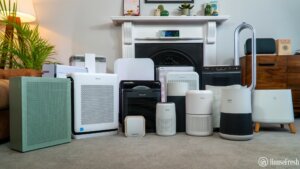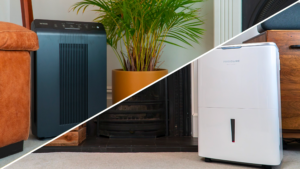Dehumidifiers are incredible machines that can help you get a handle on the moisture in your space. While the upfront cost can seem a bit expensive, they may ultimately help you save on damage caused by moisture.
In this article, we’ll cover the common signs that you may need a dehumidifier, how it could help you in your home, and some of the most commonly asked questions around use.
Ready to get into it? Let’s dive deep into the world of dehumidifiers!
Signs you need to use a dehumidifier
Humidity in your environment could be caused by anything. Perhaps you just happen to live in a particularly humid city! So, how can you tell if there’s excess moisture in your home? While some signs will be apparent, others may be less so.
These are some of the most common symptoms you may need to purchase a dehumidifier:
Sign 1: Condensation running down windows and doors
A huge tell-tale sign that there may be more humidity in your home than you would like is condensation collecting on the windows and doors. Particularly noticeable in winter, condensation collects when the outside temperature is colder than the inside temperature.
Of course, not just your windows and doors can be affected, but also your walls. This is particularly true when your home isn’t adequately insulated.
Sign 2: Spots of mold around your home
If you spy mold in your house, especially around the corners or ceiling, you have an issue with excess moisture. This can be particularly dangerous to your health, as mold spores can lead to certain symptoms commonly associated with allergies. More serious cases can also lead to black mold or cause more severe illnesses.
You’ll likely find mold in areas with high moisture concentrations in the air and inadequate ventilation, such as bathrooms, laundry areas and kitchens.
Sometimes, you must replace various materials beyond repairs, such as carpets and insulation. However, a dehumidifier will go a long way toward helping you address the underlying humidity issue in your home.
Sign 3: A funky smell in the air
Like the visible signs of mold, funky, musty smells are a good indicator of excess humidity in your environment. When molds begin to grow indoors, spores and toxins are released into the air—that’ll be those funky smells you’re sniffing out. Common areas where you may notice a stench that shouldn’t be there include bathrooms, linen closets or wardrobes and laundry rooms.
While you may be able to deal with some of this without a dehumidifier, a dehumidifier will help you address the issue at the root.
Sign 4: Wallpaper peeling or paint is bubbling
When you have significant levels of moisture inside your home, this could cause your wallpaper to peel due to the adhesive losing its effectiveness. You may even notice paint bubbling or peeling on your walls!
This is a significant indicator of excess moisture in the walls and needs addressing. If you see watermarks, you’ll want to investigate for a potential broken pipe, which could be contributing to the high humidity within your home.
Sign 5: Allergy symptoms year-round
Pests and dust mites love the damp. If your home has high humidity, this can increase pests, mites and mold. When these pests excrete, shed their skin, or release spores into the air, we breathe them in, leading to symptoms associated with asthma and other allergic reactions, such as sneezing.
If you notice that you, or someone in your household, is suffering from allergic reactions, it may be due to the humidity in your home. Lowering the humidity can make your home a less hospitable environment for these pests.
How a dehumidifier helps
Dehumidifiers work by removing excess moisture from the air. They do this by taking in the warm air in your environment through a fan. The machine contains refrigerated coils; as the warm air passes through them, it contracts and the moisture condenses.
This condensation then collects in a storage tank within the dehumidifier, a single drop at a time. The air in the coils is now cooler and drier and passes back out through the machine and into your environment.
As a bonus, since the air passing through the dehumidifier is cooler, it will also help to cool your home. Dehumidifiers may be especially helpful in areas where moisture collects. This could include your bathroom, kitchen, basement, or even attic.
Of course, you may not want a dehumidifier in every room! Even one in your house could help to reduce humidity levels if needed. You can also mitigate the effects of humidity through other methods, such as ensuring adequate ventilation in high-moisture areas. Ensuring you’re venting machines outside, such as driers and cooktops, will also help significantly.
Dehumidifiers, in general, should reduce the humidity in your home by 30–50%. The final result will depend on the size of the room and how much moisture is in the air. While dehumidifiers are extremely safe, you should still be aware of the risks of running them (as with any electrical device). Remember, a dehumidifier will only affect the moisture in the air and not clean the air. To do that, you will need an air purifier.
What to look for when choosing a dehumidifier
When choosing a dehumidifier for your home, there are several factors you should take into account. Dehumidifiers come in many sizes and can be stand-alone or incorporated into your home’s HVAC system.
To choose the right one, consider the following:
1. How much moisture is in the room?
Using a humidity meter or gauge (a hygrometer) will help you determine the moisture levels in your home. Ideally, you should keep humidity levels to around 30—50%. If it’s above this, you should consider placing a dehumidifier in that room.
However, if it’s significantly higher than this, you may want to consider a dehumidifier that can handle the excess moisture.
2. How big is the room?
Dehumidifiers have different capacities, depending on how much moisture they can remove within a 24-hour window. Therefore, depending on your room size, you’ll need a dehumidifier with a particular capacity.
As a general guide:
| 24—39-pint capacity dehumidifiers can remove moisture from rooms around: 💦 500—1,500 sq ft (damp) 💦💦 500—1,000 sq ft (very damp) 💦💦💦 500 sq ft (wet and highly wet) 40—59-pint capacity dehumidifiers can remove moisture from rooms around: 💦 2,000—2,500 sq ft (damp) 💦💦 1,500—2,000 sq ft (very damp) 💦💦💦 1,000—1,500 sq ft (wet) 💦💦💦💦 1,000 sq ft (extremely wet) 60-plus-pint capacity dehumidifiers can remove moisture from rooms around: 💦 2,500 sq ft (damp) 💦💦 2,000—2,500 sq ft (very damp) 💦💦💦 1,500—2,500 sq ft (wet) |
You’ll also need to consider other factors to determine your dehumidifier size. These include if you live in a particularly humid climate (add 10 pints), if a large number of people live in your home (add five pints), if your home or the room you’re trying to dry out has several doors or windows (add five pints), or if your laundry is nearby (add 5-pints).
In addition to the above, several different styles of dehumidifiers are available on the market. Do your research thoroughly before buying one to ensure you have the best dehumidifier for your needs!
Frequently asked questions about dehumidifiers
Though it will depend on the environment you’re trying to remove humidity from (as well as your climate), running your dehumidifier for a minimum of 12 hours a day will achieve maximum energy efficiency.
While you could run your dehumidifier for 24 hours, you should be aware that the internal components will be strained and wear out faster. It will also be more costly! Instead, it’s better to run your dehumidifier for around 12 hours. This should bring the humidity in your environment down to a comfortable 50—55%.
While you can use your dehumidifier all year round, there is the potential for cooler air to freeze the coils in your machine in the winter when the air is cooler. Therefore, it’s better not to use it in the winter unless you absolutely must! Just be sure to take precautions, such as running a heater alongside your unit for a few hours.
When you compare a dehumidifier to other household appliances, they use very little electricity. A 30-pint machine will only use 300w of energy, less than a computer. A 70-pint machine uses 700w of energy less than boiling your kettle. However, you should still look for an energy-efficient dehumidifier to maximize your electricity savings.
Wrapping up
If you notice any of the tell-tale signs of high humidity in your home, such as damp, musty smells, or mold, it could be time to invest in a dehumidifier. Remember to consider the size of your home and the specific functions of a dehumidifier to find the one best suited for you!
While you can use a dehumidifier all year round, they’re best operated in spring, summer and autumn. If you need to operate them in the winter, just take extra precautions or risk freezing the machine’s coils.
Dehumidifiers are excellent tools for removing moisture from the air. Just be sure to tackle the source of excess moisture at the root to protect your health and home fully!
SOURCES
- State of Rhode Island Department of Health. (2023). Mold Health Risks. health.ri.gov
- Centers for Disease Control and Prevention. (2023). Basic Facts about Mold and Dampness cdc.gov
- Bennett, B. and Wollerton, M. (2022). Signs You Need a Portable Dehumidifier cnet.com
- ARS Rescue Footer. (2021). Telltale Signs You Need a Dehumidifier. ars.com
- Energy Star. (2023). Dehumidifier Basics. energystar.gov







